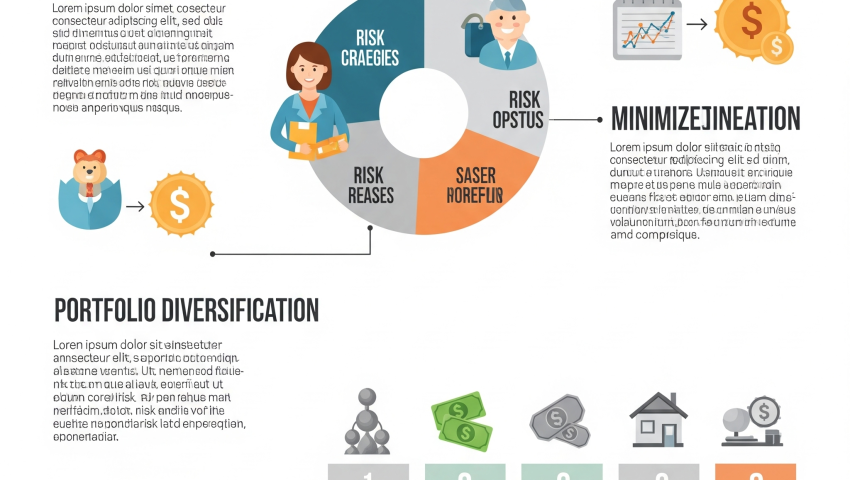
Asset Allocation Strategies
Asset Allocation Strategies
Asset Allocation Strategies
Start with a clear explanation of what asset allocation is and why it's fundamental to long-term financial success.
"Asset allocation is the cornerstone of effective investment management. It involves strategically dividing your investment portfolio among different asset categories – such as equities, fixed income, gold, and real estate – to balance risk and reward according to your unique financial goals, risk tolerance, and time horizon. Our approach ensures your portfolio is diversified, resilient, and optimized for your specific objectives."
1. Understanding the Core Principles
- Diversification as a Risk Mitigation Tool:
- Explain how different asset classes often react differently to market events (low or negative correlation).
- Highlight that diversification helps reduce overall portfolio volatility and protects against significant losses if one asset class underperforms.
- Use a simple analogy, like "not putting all your eggs in one basket."
- Risk and Return Trade-off:
- Discuss how each asset class has a distinct risk-return profile.
- Emphasize that higher potential returns typically come with higher risk, and vice versa.
- Long-Term vs. Short-Term Goals:
- Explain how asset allocation shifts based on the investment horizon for different goals.
- For short-term goals (e.g., down payment), emphasize stability and capital preservation (more debt/cash).
- For long-term goals (e.g., retirement), highlight the potential for growth and inflation-beating returns (more equity).
2. Key Asset Classes for Indian Investors
Detail the primary asset classes you consider, with a brief explanation of their role:
- Equities (Stocks):
- Description: Ownership in companies, offering potential for capital appreciation and dividends.
- Role: Long-term wealth creation, inflation-beating returns.
- Sub-categories (for further detail if you specialize): Large-cap, Mid-cap, Small-cap, Sectoral/Thematic funds, International Equities (for geographic diversification).
- For Indian investors: Highlight Nifty 50, Sensex, and the growth potential of the Indian economy.
- Fixed Income (Debt):
- Description: Lending money to governments or corporations for regular interest payments.
- Role: Portfolio stability, income generation, capital preservation, especially for short to medium-term goals.
- Examples for Indian investors: Government Bonds (G-Secs), Corporate Bonds, Fixed Deposits (FDs), Public Provident Fund (PPF), National Pension System (NPS - debt component), Debt Mutual Funds (liquid funds, ultra-short duration funds, corporate bond funds).
- Gold & Precious Metals:
- Description: A traditional safe-haven asset, often seen as a hedge against inflation and economic uncertainty.
- Role: Diversification, store of value, particularly in volatile times.
- Investment avenues in India: Physical gold, Gold ETFs, Gold Mutual Funds, Sovereign Gold Bonds (SGBs).
- Real Estate:
- Description: Tangible assets like residential or commercial properties.
- Role: Potential for rental income and capital appreciation, diversification.
- Investment avenues in India: Direct property ownership, Real Estate Investment Trusts (REITs), Infrastructure Investment Trusts (InvITs).
- Cash and Cash Equivalents:
- Description: Highly liquid assets like savings accounts, money market funds.
- Role: Emergency fund, liquidity for short-term needs, opportunistically deployable during market downturns.
3. Our Approach to Asset Allocation
- Personalized Risk Profiling:
- Explain your process for assessing a client's risk tolerance (through questionnaires, discussions) and risk capacity (financial ability to take risks).
- Emphasize that this forms the bedrock of their unique asset allocation.
- Strategic Asset Allocation (Long-Term Framework):
- Describe how you establish a long-term target allocation based on the client's goals, time horizon, and risk profile.
- Mention that this is the primary, enduring framework for the portfolio.
- Example: "For a young professional saving for retirement, a strategic allocation might be 70% equity, 20% debt, and 10% gold."
- Tactical Asset Allocation (Short-Term Adjustments - if applicable):
- (Only if you actively engage in this) Explain how you may make temporary, short-term deviations from the strategic allocation to capitalize on market opportunities or mitigate short-term risks (e.g., slightly increasing debt during a highly overvalued equity market).
- Stress that this is done cautiously and within defined limits.
- Dynamic Asset Allocation (if applicable):
- (Only if you use models that automatically adjust) Describe how the allocation changes based on market valuations or pre-defined rules (e.g., increasing equity when markets are cheap, decreasing when expensive).
- Regular Review & Rebalancing:
- Explain the importance of periodically reviewing the asset allocation to ensure it remains aligned with the client's evolving goals and market conditions.
- Describe the rebalancing process: selling overperforming assets and buying underperforming ones to bring the portfolio back to its target allocation, often optimizing for tax efficiency.
- Inflation Management: How your asset allocation strategies aim to combat inflation and ensure the real purchasing power of wealth is maintained over time, especially relevant in India.
4. Benefits of a Well-Defined Asset Allocation Strategy
- Optimized Risk-Adjusted Returns: Aiming for the best possible returns for a given level of risk.
- Protection Against Market Volatility: Cushioning the impact of market downturns.
- Achievement of Financial Goals: Staying on track to meet specific objectives.
- Peace of Mind: Knowing your investments are aligned with your overall financial plan.
- Disciplined Investing: Encouraging a systematic and rational approach rather than emotional reactions.









